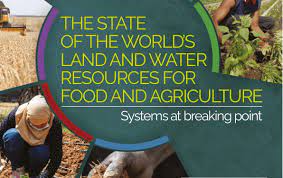The State Of The World’s Land And Water Resources For Food And Agriculture:

As per the recently released, ‘The State of the world’s land and water resources for food and agriculture (released by FAO)’, water and land resources are being pushed to limits due to human actions.
Highlights of the report:
- Sources of fodder (grassland and shrub-covered areas) have declined by 191 million hectares in the past two decades due to the conversion of this to the cropland
- Due to population increase, agricultural land available per capita for crops and animal husbandry declined by 20 per cent between 2000 and 2017 to 0.19 ha /capita in 2017.
- It was reported that almost a third of rain-fed cropland and nearly a half of irrigated land are subject to human-induced land degradation which primarily affected the fertility of the soil
- Over 60 per cent of irrigated areas are degraded in northern Africa, south Asia and the middle east-western Asia.
- The rapid growth of cities had a significant impact on land and water resources; in 2018, 55 per cent of the world’s population were urban dwellers. This meant encroachment on good agricultural land.
- Most pressures on the world’s land, soil and water resources are from agriculture due to use of chemical fertilizers, farm mechanization etc.
- The degradation of the resources might continue unabated to meet the food security needs of the ever-growing population since by 2050 agriculture will need to produce almost 50 per cent more food, livestock fodder and biofuel than in 2012 to satisfy global demand and keep on track to achieve “zero hunger” by 2030.
- Local consumption and weather patterns need to be kept in mind while formulating the policies. Ex: Avoid growing sugarcane in those areas where water is deficient; encouraging organic farming
- A meaningful engagement with the key stakeholders – farmers, pastoralists, foresters and smallholders – directly involved in managing soils and conserving water in agricultural landscapes is crucial.
- Reforms in water and land-governance policies.
- Some of the steps taken in India to prevent degradation in regard include- soil health card, scientific irrigation methods (Pradhan Mantri Krishi Sinchai Yojana, Desert development program, Pradhan Mantri Krishi Sampada Yojana etc.)




